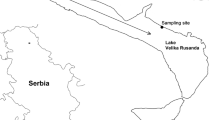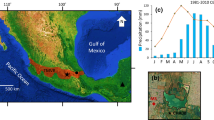Abstract
We represent Paleoenvironmetal condition of Vestfold Hills region, based on the relative abundance of a single diatom species Fragilariopsis curta, a dominating sea-ice taxon. Increase in relative abundance of F. curta in a core from Vestfold Hills representing Holocene climatic history before 3820 years BP and 5560 year BP indicates the prevalence of colder climatic conditions, as this species is known to prefer the icier condition to thrive.
Similar content being viewed by others
References
Armand, L., Crosta, X., Romero, O., and Pichon, J.J., 2005, The biogeography of major diatom taxa in Southern Ocean sediments. 1. Sea ice related species. Palaeogeography, Palaeoclimatology, Palaeoecology, 223, 93–126.
Arrigo, K.R., van Dijken, G.L., and Bushinsky, E., 2008, Primary production in the Southern Ocean, 1997–2006. Journal of Geophysical Research, 113, C08004.
Bartsch, A., 1989, Sea-ice algae of the Weddell Sea (Antarctica): species composition, biomass and ecophysiology of selected species. Report on Polar Research, 63, 110.
Beans, C., Hecq, J.H., Koubbi, P., Vallet, C., Wright, S., and Goffart, A., 2008, A study of the diatom-dominated microplankton summer assemblages in coastal waters from Terre Adélie to the Mertz Glacier, East Antarctica (1391E-1451E). Polar Biology, 31, 1101–1117.
Buffen, A., Leventer, A., Rubin, A., and Hutchins, T., 2007, Diatom assemblages in surface sediments of the northwestern Weddell Sea, Antarctic Peninsula. Marine Micropaleontology, 62, 7–30.
Burckle, L.H., Jacobs, S.S., and McLaughlin, R.B., 1987, Late austral spring diatom distribution between New Zealand and the Ross Ice shelf, Antarctica: Hydrographic and sediment correlations. Micropaleontology, 33, 74–81.
Burton, H.R. and Campbell, P.J., 1980, The Climate of the Vestfold Hills, Davis Station, Antarctica, with a Note on Its Effect on the Hydrology of Hypersaline Deep Lake. ANARE Scientific Reports, Series D Meterology Publication, 129, 1–50.
Collerson, K.D. and Sheraton, J.W., 1986, Bedrock geology and crustal evolution of the Vestfolds Hills. In: Pickard, J. (ed.), The Antarctic Oasis: Terrestrial Environments and History of the Vestfold Hills. Academic Press, Sydney, 21–62.
Cortese, G. and Gersonde, R., 2007, Morphometric variability in the diatom Fragilariopsis kerguelensis: Implications for Southern Ocean paleoceanography. Earth and Planetary Science Letters, 257, 526–544.
Crosta, X., 2009, Holocene size variations in two diatom species off East Antarctica: Productivity vs. environmental conditions. Deep Sea Research I, 56, 1983–1993.
Crosta, X., Pichon, J.J., and Burckle, L.H., 1998a, Application of the modern analog technique to marine Antarctic diatoms: reconstruction ofmaximum sea-ice extent at the Last Glacial Maximum. Paleoceanography, 13, 284–297.
Crosta, X., Pichon, J.J., and Burckle, L.H., 1998b, Reappraisal of Antarctic seasonal sea ice at the Last Glacial Maximum. Geophysical Research Letters, 25, 2703–2706.
Crosta, X., Denis, D., and Ther, O., 2008, Sea ice seasonality during the Holocene, Adélie Land, East Antarctica. Marine Micropaleontology, 66, 222–232.
Cunningham, W.L. and Leventer, A., 1998, Diatom assemblages in surface sediments of the Ross Sea: relationship to present oceanographic conditions. Antarctic Science, 10, 134–146.
Esper, O., Gersonde, R., and Kadagies, N., 2010, Diatom distribution in southeastern Pacific surface sediments and their relationship to modern environmental variables. Palaeogeography, Palaeoclimatology, Palaeoecology, 287, 1–27.
Garrison, D.L., Sullivan, C.W., and Ackley, S.F., 1986, Sea-ice microbial communities in Antarctica. Bioscience, 36, 243–250.
Gersonde, R. and Zielinski, U., 2000, The reconstruction of late Quaternary Antarctic sea-ice distribution — the use of diatoms as a proxy for sea-ice. Palaeogeography, Palaeoclimatology, Palaeoecology, 162, 263–286.
Gersonde, R., 1986, Siliceous microorganisms in sea-ice and their record in sediments of the southern Weddell Sea (Ant arctica). In: Ricard, M. (ed.), Proceedings of the 8th International Diatom Symposium, Paris 1984. Költz, Königstein, 549–566.
Gibson, J.A., 1998, Carbon flow through inshore marine environments of the Vestfold Hills, East Antarctica. ANARE Scientific Reports, 139, 221.
Gleitz, M., Bartsch, A., Diekmann, G.S., and Eicken, H., 1998, Composition and succession of sea-ice diatom assemblages in the eastern and southern Weddell Sea Antarctica. In: Lizotte, M.P., and Arrigo, K.R. (eds.), Antarctic Sea-ice Biological Processes: Interactions and Variability. Washington D.C., American Geophysical Union (Antarctic Research Series 73), 107–120.
Hargraves, P.E., 1980, Species composition and distribution of net plankton diatoms in the Pacific sector of the Antarctic Ocean. Ph.D. Thesis, School of Marine Science, College of Williams and Mary, Virginia, 170 p.
Hendey, N.J., 1937, The plankton diatoms of the southern seas. Discovery Report, 16, 151–364.
Hodgson, D.A., Doran, P.T., Roberts, D., and McMinn, A., 2004, Paleolimnological studies from the Antarctic and subantarctic islands. In: Pienitz, R., Douglas, M.S.V., and Smol, J.P. (eds.), Longterm environmental change in Arctic and Antarctic lakes. Dordrecht, Springer (Developments in Palaeoenvironmental Research 8), 419–474.
Kang, S.-H. and Fryxell, G.A., 1992, Phytoplankton in the Weddell Sea, Antarctica. Composition, abundance and distribution in the water-column assemblages of the marginal ice-edge zone during austral summer. Marine Biology, 116, 335–348.
Kellogg, D.E. and Kellogg, T.B., 1987, Microfossil distributions in modern Amundsen Sea sediments. Marine Micropaleontology, 12, 203–222.
Kerry, K.R., Woehler, E.J., Wright, S., and Dong, Z., 1987a, Oceanographis data: Prydz Bay region-MV Nella Dan, January-March 1981. ANARE Research Notes, 49, 114.
Kerry, K.R., Woehler, E.J., and Robb, M.S., 1987b, Oceanographic data: Prydz Bay region-SIBEX II, MV Nella Dan, January 1985. ANARE Research Notes, 53, 122.
Kozlova, O.G., 1962, Specific composition of diatoms in the waters of the Indian sector of Antarctica. Tr. Inst. Okeanol. Akad. Nauk SSSR, 61, 3–18.
Leventer, A., 1992, Modern distribution of diatoms in sediments from the George V Coast, Antarctica. Marine Micropalentology, 19, 315–332.
Leventer, A., 1998, The fate of Antarctic ‘sea-ice diatoms’ and their use as paleoenvironmental indicators. In: Lizotte, M.P. and Arrigo, K.R. (eds.), Antarctic Sea-ice, Biological Processes, Interactions and Variability. Washington D.C., American Geophysical Union (Antarctic Research Series 73), 121–137.
Leventer, A. and Dunbar, R.B., 1988, Recent diatom record of McMurdo Sound, Antarctica: Implications for history of sea-ice extent. Paleoceanography, 3, 259–274.
Leventer, A. and Dunbar, R.B., 1996, Factors influencing the distribution of diatoms and other algae in the Ross Sea. Journal of Geophysical Research, 101, 18489–18500.
Manguin, E., 1957, Premier Inventaire des Diatomées de la Terre Adélie Antarctique. Espéces nouvelles. Revue Algologique, 3, 111–134.
O’Brien, S.R., Mayewski, P.A., Meeker, L.D., Meese, D.A., Twickler, M.S., and Whitlow, S.I., 1995, Complexity of Holocene climate as reconstructed from a Greenland ice core. Nature, 270, 1962–1964.
Palmisano, A.C. and Garrison, D.L., 1993, Microorganisms in Antarctic sea-ice. In: Friedman, I. (ed.), Antarctic Microbiology, New York, Wiley-Liss, 167–218.
Pickard, J., 1986, Antarctic oases, Davis station and the Vestfold Hills. In: Pickard, J. (ed.), Antarctic Oasis, Sydney, N.S.W., Academic Press, 1–19.
Renssen, H., Goosse, H., Fichefet, T., Masson-Delmotte, V., and Koc, N., 2005, Holocene climate evolution in the high-latitude Southern Hemisphere simulated by a coupled atmosphere-sea-iceocean-vegetation model. The Holocene, 15, 951–964.
Round, F.E., Crawford, R.M., and Mann, D.G., 1990, The diatoms: biology and morphology of the genera. Cambridge University Press, Cambridge, 747 p.
Sambrotto, R.N., Matsuda, A., Vaillancourt, R., Brown, M., Langdon, C., Jacobs, S.S., and Measures, C., 2003, Summer plankton production and nutrient consumption patterns in the Mertz Glacier region of East Antarctica. Deep-Sea Research II, 50, 1393–1414.
Schwerdtfeger, W., 1970, The climate of the Antarctic. In: Orvig, S. (ed.), World Survey of Climatology, Climates of the Polar Regions, Elsevier, 14, 253–355.
Setty, M.G.A.P., 1966, Preparation and method of study of fossil diatoms. Micropaleontology, 12, 511–514.
Shevenell, A., Domack, E.W., and Kernan, G.M., 1996, Record of Holocene palaeoclimate change along the Antarctic Peninsula: evidence from glacial marine sediments, Lallemand Fjord. Papers and Proceedings of the Royal Society of Tasmania, 130, 55–64.
Sokal, R. and Rohlf, F., 1994, Biometry: The Principles and Practice of Statistics in Biological Research. Freeman & Company, W.H., New York, 88 p.
Tanimura, Y., 1992, Distribution of diatom species in the surface sediments of Lützow Holm Bay, Antarctica. In: Ishizaki, K. and Saito, T. (eds.), Centenary of Japan Micropaleontology, 399–411.
Tanimura, Y., Fukuchi, M., Watanabe, K., and Moriwaki, K., 1990, Diatoms in water column and sea-ice in Lützow-Holm Bay, Antarctica and their preservation in the underlying sediments. Bulletin of the National Science Museum, Tokyo, Series C, 18, 15–39.
Taylor, F., Whitehead, J., and Domack, E., 2001, Holocene paleoclimate change in the Antarctic Peninsula: evidence from the diatom, sedimentary and geochemical record. Marine Micropaleontology, 41, 25–43.
Truesdale, R.S. and Kellogg, T.B., 1979, Ross Sea diatoms: modern assemblage distribution and their relationship to ecologic, oceanographic, and sedimentary conditions. Marine Micropaleontology, 4, 13–31.
Vaillencourt, R.D., Sambrotto, R.N., Green, S., and Matsuda, A., 2003, Phytoplankton biomass and photosynthetic competency in the summertime Mertz Glacier region of East Antarctica. Deep-Sea Research II, 50, 1415–1440.
Verleyen, E., Hodgson, D.A., Sabbe, K., and Vyverman, W., 2004, Late Quaternary deglaciation and climate history of the Larsemann Hills (East Antarctica). Journal of Quaternary Science, 19, 361–375.
Wilson, D.L., Smith, W.O., Jr., and Nelson, D.M., 1986, Phytoplankton bloom dynamics of the western Ross Sea-ice edge — I. Primary productivity and species-specic production. Deep-Sea Research, 33, 1375–1387.
Wright, S.W. and Enden, R.L., 2000, Phytoplankton community structure and stocks in the East Antarctic Marginal ice zone (BROKE survey, January-March 1996) determined by CHEMTAX analysis of HPLC pigment signatures. Deep-Sea Research II, 47, 2363–2400.
Yoon, H.I., Park, B.K., Kim, Y., and Kang, C.Y., 2002, Glaciomarine sedimentation and its paleoclimatic implications on the Antarctic Peninsula shelf over the last 15,000 years. Palaeogeography, Palaeoclimatology, Palaeoecology, 185, 235–254.
Zielinski, U. and Gersonde, R., 1997, Diatom distribution in Southern Ocean surface sediments (Atlantic sector): Implications for paleoenvironmental reconstructions. Palaeogeography, Palaeoclimatology, Palaeoecology, 129, 213–250.
Author information
Authors and Affiliations
Corresponding author
Rights and permissions
About this article
Cite this article
Mazumder, A., Govil, P., Ravindra, R. et al. Indication of colder condition within Holocene period in a freshwater lake in Vestfold Hills area, East Antarctica region. Geosci J 17, 235–239 (2013). https://doi.org/10.1007/s12303-013-0015-1
Received:
Accepted:
Published:
Issue Date:
DOI: https://doi.org/10.1007/s12303-013-0015-1




